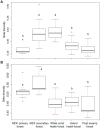Distinctive Tropical Forest Variants Have Unique Soil Microbial Communities, But Not Always Low Microbial Diversity
- PMID: 27092105
- PMCID: PMC4820907
- DOI: 10.3389/fmicb.2016.00376
Distinctive Tropical Forest Variants Have Unique Soil Microbial Communities, But Not Always Low Microbial Diversity
Abstract
There has been little study of whether different variants of tropical rainforest have distinct soil microbial communities and levels of diversity. We compared bacterial and fungal community composition and diversity between primary mixed dipterocarp, secondary mixed dipterocarp, white sand heath, inland heath, and peat swamp forests in Brunei Darussalam, Northwest Borneo by analyzing Illumina Miseq sequence data of 16S rRNA gene and ITS1 region. We hypothesized that white sand heath, inland heath and peat swamp forests would show lower microbial diversity and relatively distinct microbial communities (compared to MDF primary and secondary forests) due to their distinctive environments. We found that soil properties together with bacterial and fungal communities varied significantly between forest types. Alpha and beta-diversity of bacteria was highest in secondary dipterocarp and white sand heath forests. Also, bacterial alpha diversity was strongly structured by pH, adding another instance of this widespread pattern in nature. The alpha diversity of fungi was equally high in all forest types except peat swamp forest, although fungal beta-diversity was highest in primary and secondary mixed dipterocarp forests. The relative abundance of ectomycorrhizal (EcM) fungi varied significantly between forest types, with highest relative abundance observed in MDF primary forest. Overall, our results suggest that the soil bacterial and fungal communities in these forest types are to a certain extent predictable and structured by soil properties, but that diversity is not determined by how distinctive the conditions are. This contrasts with the diversity patterns seen in rainforest trees, where distinctive soil conditions have consistently lower tree diversity.
Keywords: Southeast Asia; biodiversity; microbial communities; soil pH; tropical rainforest.
Figures





Similar articles
-
Distinctive Soil Archaeal Communities in Different Variants of Tropical Equatorial Forest.Microb Ecol. 2018 Jul;76(1):215-225. doi: 10.1007/s00248-017-1118-4. Epub 2017 Nov 29. Microb Ecol. 2018. PMID: 29184976
-
Soil Type Has a Stronger Role than Dipterocarp Host Species in Shaping the Ectomycorrhizal Fungal Community in a Bornean Lowland Tropical Rain Forest.Front Plant Sci. 2017 Oct 27;8:1828. doi: 10.3389/fpls.2017.01828. eCollection 2017. Front Plant Sci. 2017. PMID: 29163567 Free PMC article.
-
Determinants of Soil Bacterial and Fungal Community Composition Toward Carbon-Use Efficiency Across Primary and Secondary Forests in a Costa Rican Conservation Area.Microb Ecol. 2019 Jan;77(1):148-167. doi: 10.1007/s00248-018-1206-0. Epub 2018 Jun 1. Microb Ecol. 2019. PMID: 29858646
-
Geographical variation in soil bacterial community structure in tropical forests in Southeast Asia and temperate forests in Japan based on pyrosequencing analysis of 16S rRNA.Genes Genet Syst. 2017 Sep 12;92(1):1-20. doi: 10.1266/ggs.16-00013. Epub 2016 Dec 21. Genes Genet Syst. 2017. PMID: 28003572
-
The impact of selective-logging and forest clearance for oil palm on fungal communities in Borneo.PLoS One. 2014 Nov 18;9(11):e111525. doi: 10.1371/journal.pone.0111525. eCollection 2014. PLoS One. 2014. PMID: 25405609 Free PMC article.
Cited by
-
Linking prokaryotic community composition to carbon biogeochemical cycling across a tropical peat dome in Sarawak, Malaysia.Sci Rep. 2021 Mar 19;11(1):6416. doi: 10.1038/s41598-021-81865-6. Sci Rep. 2021. PMID: 33742002 Free PMC article.
-
Comparison of the Structure and Diversity of Root-Associated and Soil Microbial Communities Between Acacia Plantations and Native Tropical Mountain Forests.Front Microbiol. 2021 Sep 29;12:735121. doi: 10.3389/fmicb.2021.735121. eCollection 2021. Front Microbiol. 2021. PMID: 34659163 Free PMC article.
-
Draft Genome Sequence of Paraburkholderia sp. Strain C35, Isolated from a Malaysian Tropical Peat Swamp Forest.Genome Announc. 2018 Jun 21;6(25):e00561-18. doi: 10.1128/genomeA.00561-18. Genome Announc. 2018. PMID: 29930066 Free PMC article.
-
Distinctive Soil Archaeal Communities in Different Variants of Tropical Equatorial Forest.Microb Ecol. 2018 Jul;76(1):215-225. doi: 10.1007/s00248-017-1118-4. Epub 2017 Nov 29. Microb Ecol. 2018. PMID: 29184976
-
Microbial Community Structure in a Malaysian Tropical Peat Swamp Forest: The Influence of Tree Species and Depth.Front Microbiol. 2018 Dec 4;9:2859. doi: 10.3389/fmicb.2018.02859. eCollection 2018. Front Microbiol. 2018. PMID: 30564202 Free PMC article.
References
-
- Allen S. E. (1989). Chemical Analysis of Ecological Materials. Oxford: Blackwell Scientific Publications.
-
- Andriesse J. (1988). Nature and Management of Tropical Peat Soils. Rome: Food and Agriculture Organization of the United Nations Soils Bulletin; 59 165.
-
- Araujo J. F., de Castro A. P., Costa M. M., Togawa R. C., Júnior G. J. P., Quirino B. F., et al. (2012). Characterization of soil bacterial assemblies in Brazilian savanna-like vegetation reveals acidobacteria dominance. Microb. Ecol. 64 760–770. - PubMed
-
- Ashton P. S. (1988). Dipterocarp biology as a window to the understanding of tropical forest structure. Ann. Rev. Ecol. Syst. 19 347–370. 10.1146/annurev.es.19.110188.002023 - DOI
LinkOut - more resources
Full Text Sources
Other Literature Sources

